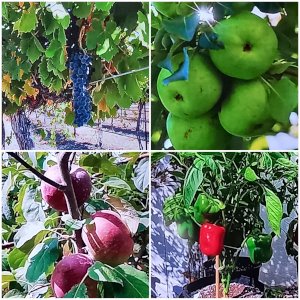We know that organic, home grown produce is much better tasting but growing your own is also safer when grown without pesticides.
This information is from EWG (Environmental Working Group USA) so use your own judgement as to its accuracy also, Australian standards could vary but the bottom line is that most of us know that these commercially grown foods are laden with non organic substances which are not conducive to a healthy body.
I do believe most of Australian farmers try to do the right thing however, governments and governing bodies put restrictions and demands on farmers, not to mention the ridiculous criteria from supermarkets which become inhibiting for the little profit farmers can make which leads to short cuts and practices that are not ideal. To be fair, commercial farming couldn't produce enough food organically and cost effectively for the masses and there is a large percentage of populations around the world that are happy to buy the lower cost, chemically laden produce however, growing your own is not only healthier and the taste is exceptional in comparison but also extremely cost effective once your beds are set up.
Another alternative is to support our local farmers who choose to use non/low spray options.
Below from least to most contaminated crops according to EWG:
- Green Beans
Most tested were contaminated.
Beans are one of the easiest crops to grow and have prolific harvests, easy to save seeds and germinate. - Blue Berries
They need a more acidic soil and suit containers best but if the soil conditions are right, they produce well. - Cherries
Not the easiest to grow in warmer climates but different varieties are being bred. I would be interested in hearing about any successful cherry growing you have experienced. - Capsicum and Chillies
Over 100 different pesticides have been found in these commercial crops. Another very easy crop to grow and chillies, in particular, can give a bumper crop. In SE Queensland, fruit fly can be a problem so netting may be required. - Apples
Easy to grow in ground or dwarf varieties in large containers and there are now low chill varieties for warmer climates. They are prolific fruiterer so you can share with family and friends. - Nectarines
90% tested had two or more pesticides. Like apples, there are differing varieties and sizes to suit every yard. - Pears
The amount of pesticides found on and in pears over the past 15 years has accelerated from under 5% to around 60%. Being such a popular fruit, is it any wonder people are experiencing bad health. Nashy pears are more suited to our climate. - Peaches
99% of samples tested were contaminated with up to 59 different pesticides. They are better suited to a cooler climate however, there are now varieties for SE Queensland but they definitely need to be netted as birds love them. - Grapes
90% tested were positive to two or more pesticides. Grapes don't have too many problems with insects or disease but birds love them. - Kale, Collard and Mustard Greens
60% tested were positive for a pesticide that has been banned in Europe for 15 years and 86% of all samples containing two of more residues of different pesticides.
All these vegetables are extremely fast and easy to grow for a large portion of the year in our climate. - Spinach
Spinach, by weight, has the most pesticide residue than any other produce.
40% of spinach tested by the American Department of Agriculture contained traces of DDT which was banned worldwide in the 70s which proves you can never be certain that some commercial producers do the right thing.
Spinach is very easy to grow/propagate and can easily be dehydrated and/or powdered for use out of season. - Strawberries
An absolute favourite to most, its disheartening that this delicious fruit is classed as the most dangerous. Some samples tested had residues of 82 different pesticides.
Easy to grow, have a small footprint ratio to the amount of harvest makes it an easy choice to grow your own. Strawberries suit container gardening very well and can be grown in the smallest yards. In our climate, Winter is the main growing season when insects are rarely a problem. also, the fruit can be easily dried or frozen for use during the warmer months if you choose not to grow them then.
Australia imports a huge amount of produce and we are beholding to the growing standards of those countries so the choice becomes easy.
I don't have enough room you may think, well most produce that sprawls out can be grown vertically and containers are ideal for a huge number of fruits and vegetables.
Gardening is certainly not for all so bartering with your friends is another option.
Let's get talking about your ideas to put healthy produce on your plate and help out our friends and neighbours and what can we do as a community to get away from the supermarkets 🍇🍓🥑🍏🍍🥦😃😃

